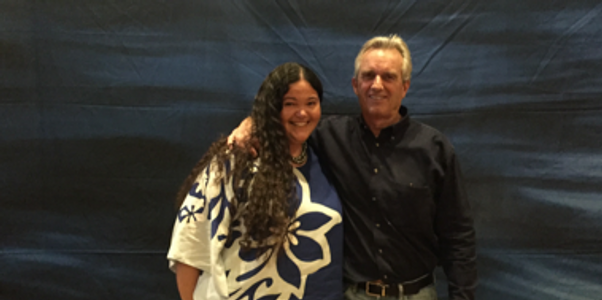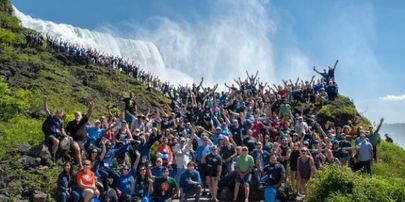About Us

Waiwai Ola Waterkeepers Hawaiian Islands is an environmental non-profit organization. Since 2017, Waterkeepers have grown across the state to include O'ahu Waterkeeper, Kona Coast Waterkeeper, and Hilo Bay Waterkeeper. Waterkeepers work to protect the ability of present and future generations to swim, fish, drink, and otherwise use and enjoy the waters that support the people and culture of Hawai‘i.
Rhiannon “Rae” Tereari‘i Chandler-‘Īao (pictured here with Robert F. Kennedy Jr.) serves as the Executive Director. After graduating from William S. Richardson School of Law in 2016 with certificates in both Native Hawaiian Rights Law and Environmental Law, she worked as a Post-J.D. Research & Teaching Fellow at Ka Huli Ao Center for Excellence in Native Hawaiian Law.
Prior to attending law school, Rhiannon served as the Executive Director of the environmental non-profit organization Community Work Day Program, d.b.a. Mālama Maui Nui. While on Maui, she served as a member of the Maui County Cultural Resources Commission, the Maui Nui Marine Resource Council, and the Steering Committee of Ka Ipu Kukui Fellows Leadership Program.
Waterkeepers Hawaiian Islands is led by President: Wendy Wiltse, Ph.D., Vice President: Denise Darval-Chang, Treasurer: Maile Goo, Psy.D., Secretary: Nikki DeHeart, and Leslie Sullivan, as well as Advisory Council Members of Kona Coast Waterkeeper and Hilo Bay Waterkeeper.

About Waterkeeper Alliance
Waterkeeper Alliance is a global movement to protect water resources, currently uniting more than 350 Waterkeeper Organizations and Affiliates throughout over 47 countries in the Americas, Europe, Australia, Asia and Africa.
We are engaging in innovative solutions to address local water quality challenges.
Every day, polluted runoff and pathogens from antiquated wastewater infrastructure contaminate our fresh and marine water resources. Many popular beaches across the islands have been closed repeatedly due to concerns for water quality.
Through water quality monitoring activities, bioremediation projects, and community partnerships, Waterkeepers are tracking the health of our waters and responding with innovative solutions across the State.
Clean Water Under Our Homes
In partnership with the Hawai‘i Department of Health, we are working to educate residents about low cost alternatives to cesspools. More efficient wastewater infrastructure will reduce bacteria levels and pathogens in our water resources.
Mahalo to our Volunteers!

Assessing conditions and monitoring water quality. Oysters need the right amount of salinity, temperature, and food availability to survive and thrive.

Maintaining cages and recording surrounding organisms. There are many predators in the water. Volunteers clear predators like crabs, worms, and small fish from the cages.

Caring for oysters and measuring growth rates. Volunteers measure oysters monthly and track growth rates across various locations.

Gathering trash on the surface of the water. Our surfers and paddlers are on the front lines of Hawai'i's water quality reality. We appreciate you!

Tracking the health of our watersheds, one cleanup event at a time!
Copyright © 2021 Waiwai Ola Waterkeepers Hawaiian Islands - All Rights Reserved.
Artwork by Solomon Enos.
Photo Credits: Waterkeeper Alliance photos: John Wathen; Oysters photos - Example of Black-lip Pearl Oysters Growing on Lines: Photo by Arthur Read, Smaller Native Hawaiian Oysters: Photo by Dr. Maria Haws; Painting of Queen Lili'uokalani from Ali'i Place: Photo by Rhiannon Chandler-'Iao